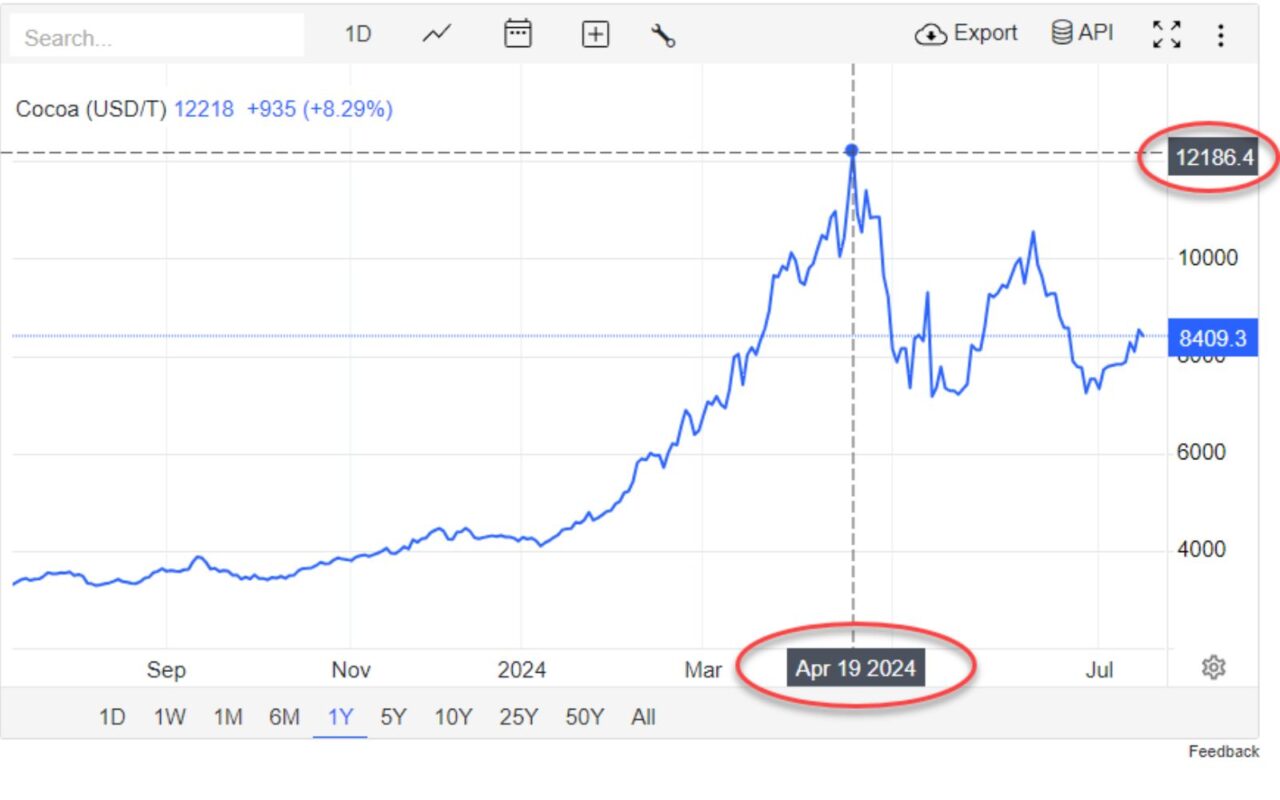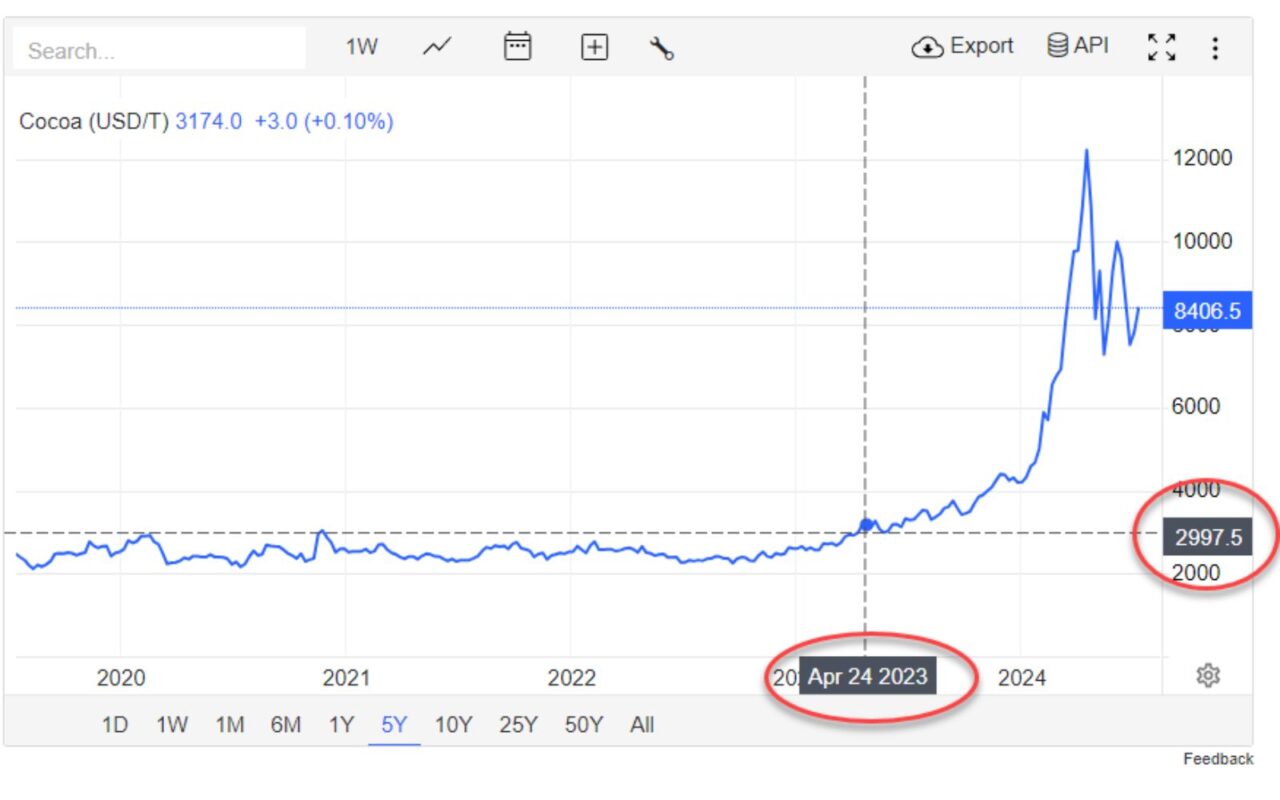These are challenging times for both chocolate enthusiasts and producers alike. The current cacao crisis has dealt us a heavy blow, compelling us to make tough decisions we wish we could avoid. Like many other chocolate makers, we now find ourselves in a position where adjusting our prices is crucial to ensure the sustainability of our business.
The first signs emerged late last year. By early 2024, it became inevitable: the world is experiencing its most severe cacao crisis to date, with prices soaring to unprecedented levels. How did we reach this point, and what does this mean for your beloved Zotter Chocolate?
Understanding the Crisis
The crisis began with reports of cocoa crop failures in Africa and rising prices as early as December 2023. In the two main cocoa-producing countries, Ivory Coast and Ghana (which together account for over 60% of global production), excessive rainfall before the main harvests in the fall caused many cocoa fruits to rot and trees to become infected with fungal diseases.
Initially, concerns were focused on the increased cost of chocolate during the holiday season. However, by the beginning of 2024, the true extent of the crisis began to unfold. Leading chocolate manufacturers quickly implemented proactive strategies to stockpile cocoa beans. The result: the world market price of raw cocoa skyrocketed from February onwards, reaching historic highs that quickly overshadowed the previous major cocoa crisis of 1974. By April 19, 2024, the price per ton of raw cocoa hit an incredible $12,186, marking an increase of over 400% compared to the previous year.
Cacao and Climate Change
Climate change is an uncontrollable stressor for the entire cocoa system, particularly evident in the global south for some time now. This ubiquitous phenomenon is increasingly noticeable even in our latitudes. Near the equator, where temperatures are rising and water is becoming scarcer, the slipping away of climate goals is particularly pronounced. The delicate rainforest ecosystems, exclusive habitats of the cocoa tree, face mounting pressure.
Furthermore, other weather phenomena, not directly attributable to climate change, can exacerbate conditions in tropical countries, such as the recent El Niño phenomenon.
Cacao and El Niño
The weather phenomenon El Niño occurs at regular intervals in the Pacific Ocean. The extent to which climate change influences this phenomenon is still under research. El Niño alters ocean currents in the Pacific, triggering a series of weather events that impact numerous regions worldwide. These events range from severe droughts, as observed in the Amazon region, to storms and heavy rainfall. El Niño disrupts global weather patterns significantly, with notable effects also felt in Latin American countries, where much of the fine cocoa cultivation occurs. These regions often experience the destruction of large stands of trees due to storms and other related phenomena.
Exploitative Cocoa Cultivation in Monocultures
To meet the global demand for cocoa, traditional cocoa cultivation in monocultures has historically been relied upon. However, this method, predominantly practiced in African countries, only boosts cultivation efficiency in the short term. Clearing rainforest areas for these monocultures destroys biodiversity, leading to soil degradation exacerbated by pesticides and fertilizers. Cocoa trees, typically grown in the natural shade of larger rainforest trees, require excessive watering in regions already grappling with water scarcity, making them vulnerable to diseases. Last year’s unusually heavy rainfall in Ghana and Côte d’Ivoire underscored the vulnerability of these fragile monocultures to severe weather events and the impacts of climate change.
The case of Ghana
Another significant issue exacerbated by the situation in Ghana, the world’s second-largest cocoa-producing country, is the rapid shrinkage of cocoa-growing areas due to illegal gold mining and environmental crimes. Illegal gold miners, known as Galamsey, frequently invade farms in search of gold, quickly destroying tree stands and contaminating soils with chemicals like cyanide. Cocoa farmers are left helpless as their livelihoods are destroyed, with some resorting to voluntarily selling their farms to Galamsey. Local authorities struggle to combat these illegal activities, often facing violent resistance from Galamsey groups, which allows the problem to rapidly escalate. A study conducted four years ago highlighted that at least 20,000 hectares of cocoa cultivation area had already been decimated by illegal gold mining, though current figures are not readily available.
Estimates indicate that cocoa cultivation areas in West Africa will face substantial reductions in the future due to illegal gold mining, tree diseases, and climate change. One study predicts that over 50% of the cocoa-growing areas in Ivory Coast could vanish by 2050. This trend suggests a potential shift in cocoa production away from depleted African regions towards Latin America.
Speculators and stockpiling fuel the crisis
If cocoa prices had already risen due to adverse conditions and limited availability, the beginning of 2024 introduced additional detrimental strategies in the cocoa market, exacerbating an already critical situation. On one hand, emotion-driven stockpiling further reduced cocoa availability. Major cocoa processors and chocolate manufacturers worldwide, equipped with extensive storage capacities, began hoarding cocoa as a precautionary measure. In Latin America, where harvests were comparatively better than in Africa, targeted initiatives were implemented to procure cocoa from farmers. Cocoa was swiftly bought up at street level due to temporarily enticing prices, causing farmers to deliver less cocoa than agreed upon to their cooperatives. This disrupted trade relations with cocoa processors, as contracted harvest quantities were not met, benefiting the corporations employing such tactics amidst this volatile pricing environment.
On the other hand, hedge funds and a significant influx of speculators into the stock exchange provided further impetus, leading to a significant increase in cocoa prices. These speculators were typically no longer active market participants but rather trading bots controlled by algorithms. These bots executed lightning-fast trading transactions, driving cocoa prices to unprecedented heights.

Image shows prices on April 19th 2024

Image shows prices on April 24th 2023
Zotter Chocolates’ Response
At Zotter Chocolates, our commitment has always been to create exceptional chocolates that delight your senses and nourish your soul. However, as we face the largest cacao crisis in history, we feel compelled to share a journey that extends beyond the sweetness of our treats.
Finding a New Path Forward
We are diligently working to find a new pricing strategy that allows us to continue operating sustainably without passing on the full extent of cost increases to you, our valued customers. Our goal is to strike a balance—a digestible price that reflects the true value of our chocolates and the hard work of our farmers, while also ensuring our long-term viability.
By the end of July, we will announce our final decision regarding pricing adjustments. This decision is not taken lightly. We understand the impact it may have on you and share in the frustration of these necessary changes. As we strive to weather this storm, your empathy and support are more crucial than ever.
We at Zotter Chocolates are committed to continuing our tradition of not cutting corners in our production and maintaining the high quality of ingredients we use. We refuse to compromise our recipes by incorporating any cheap ingredients or fillers, such as palm oil, hydrogenated oils, or other vegetable oils and fats that may soon flood the market, even though they could potentially make prices more digestible at the expense of quality. Our dedication is to uphold the quality promise our customers have relied on for decades.
Join Us on this Journey
As you enjoy Zotter Chocolates, we invite you to join us on this journey of resilience and determination. Together, we can support sustainable cocoa farming practices and preserve the future of artisanal chocolate-making. Your continued trust and understanding inspire us to innovate and persevere, ensuring that every Zotter chocolate experience remains exceptional.
Conclusion
In these uncertain times, Zotter Chocolates stands firm in our mission to provide you with chocolates that are not only delicious but also ethically sourced and sustainable. As we navigate the challenges posed by the cacao crisis, your understanding and support are invaluable. Together, we will emerge stronger, ensuring a future where chocolate remains a source of joy and connection for generations to come.


